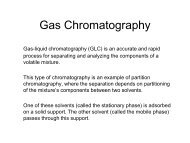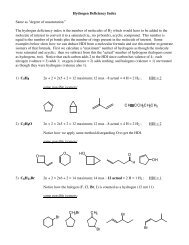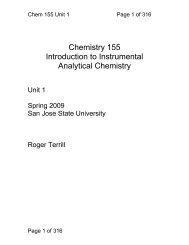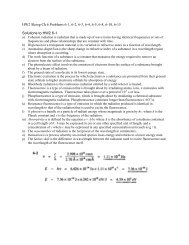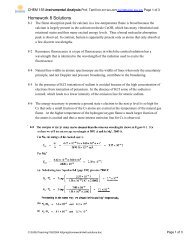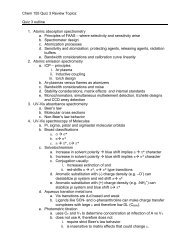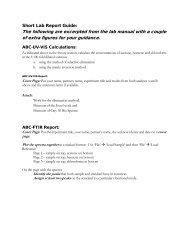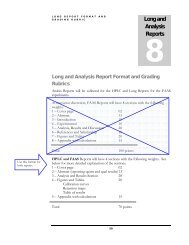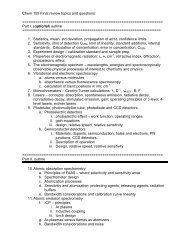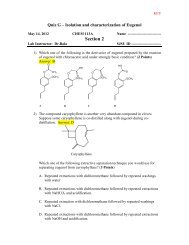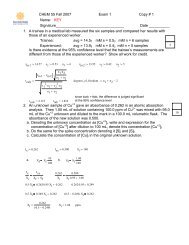Answers to HW Questions
Answers to HW Questions
Answers to HW Questions
Create successful ePaper yourself
Turn your PDF publications into a flip-book with our unique Google optimized e-Paper software.
<strong>Questions</strong> we have answered:Chem 250 Fall 2008<strong>Answers</strong> <strong>to</strong> questions given in class 8.27.081.15. A strong cation exchange resin contains sulfonic acid (a strong acid) residues.Assume the solution pH is 7.5.1.15.1. Will all proteins bind <strong>to</strong> this resin?No, a cation exchange resin has anionic (strong acid) groups on the surface such as R-SO3 - . Therefore it will bind proteins that are either net cationic or that have at least somepatches of positive charge on the surface. It will not bind purely anionic proteins. It willnot bind proteins with a pI above the buffer pH = 7.5.1.15.2. How will proteins bind <strong>to</strong> this resin?Electrostatic attraction between cationic (lysine and arginine) groups on the protein’speriphery and sulfonates on the resin.1.15.3. Will this be a mono- or multi-valent binding interaction? (Note thatmultivalent interactions such as DNA duplexation have characteristicallysharp association isotherms.)The likelihood is that this will be multivalent. The more lysine groups on the proteinsurface, the more points of attraction and the stronger the binding.1.15.4. Why would increasing ionic strength of, e.g. NaCl decrease thestrength of this binding interaction?Increasing ionic strength will tend <strong>to</strong> elute the protein. One can think of this as acompetitive binding effect (like the Na + in the solution competes with lysine + for thesulfonate) or as a charge screening effect wherein at high ionic strength ions in solutionsimply tend <strong>to</strong> cancel electric fields and prevent the normal electrostatic interactions fromextending beyond a few angstroms.1.15.5. On what basis will this separation work?The separation will work on the basis of the strength of the cation-anion attractionbalanced against the solvating (enthalpic) and liberating (entropic) energies of releasingthe protein.1.16. On what basis does reverse-phase chroma<strong>to</strong>graphy separate analytes?Hydrophobicity – or, the tendency of non-polar components of the solution <strong>to</strong> stick <strong>to</strong> orpartition in<strong>to</strong> the oily coating on the chroma<strong>to</strong>graphic stationary phase.



